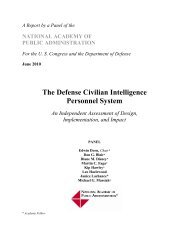Accenture's fifth annual global e-government study
Accenture's fifth annual global e-government study
Accenture's fifth annual global e-government study
You also want an ePaper? Increase the reach of your titles
YUMPU automatically turns print PDFs into web optimized ePapers that Google loves.
2004 key findings<br />
eGovernment leaders are<br />
reaping tangible savings<br />
When <strong>government</strong>s began their online programs<br />
several years ago, their initial objectives were to provide<br />
service improvements and alternate channels<br />
of delivery. Cost savings were a hoped-for result—<br />
a potential by-product, rather than a certainty. Few<br />
countries realized significant cost savings in those<br />
early years.<br />
This year, we see evidence that the focus for many<br />
<strong>government</strong>s is now specifically on the cost savings<br />
potential of eGovernment. This is not surprising,<br />
given that most <strong>government</strong>s currently operate in<br />
an environment of severe fiscal constraints. Other<br />
<strong>government</strong>s seem loath to make the investments<br />
needed to build a robust eGovernment program. This<br />
may be a costly, shortsighted move, however,<br />
as we see evidence that a number of eGovernment<br />
leaders already are reaping tangible savings on their<br />
way to high performance.<br />
Canada, for example, recently conducted a comparison<br />
of channel costs per transaction that showed<br />
the cost savings from online service are significant.<br />
Its survey showed that an in-person transaction<br />
costs the <strong>government</strong> Can$44, a mail transaction<br />
costs Can$38 and a telephone (agent) transaction<br />
costs Can$8. In contrast, an online transaction costs<br />
less than Can$1.<br />
In other countries, individual agencies exhibit some<br />
of the clearest examples of the potential cost savings<br />
benefits from eGovernment. Revenue agencies in<br />
particular show the results of most countries’ early<br />
focused development. In Norway, the Inland Revenue<br />
Department (Skatteetaten), www.skatteetaten.no,<br />
Reflections from a world leader<br />
Michelle d’Auray, CIO of the Canadian <strong>government</strong>, shares her thoughts on what leads to high performance<br />
in eGovernment and on the challenges Canada faces as it looks to its eGovernment future.<br />
How do you define high-performance eGovernment<br />
High-performance eGovernment is one that meets citizens’ needs, that has a huge degree of seamlessness and<br />
ease of access, that has a speedy response time and that essentially challenges the way of doing things traditionally.<br />
Put the [customer] first and provide the [customer] with the whole of <strong>government</strong> at his or her disposal.<br />
Do you have a guiding principle for eGovernment<br />
Citizens and businesses don’t care what level of <strong>government</strong> they interact with, they just want to be able to<br />
get things done.<br />
What has the Canadian <strong>government</strong> done right in its own eGovernment program<br />
The direction [of our program] was predicated on very extensive polling and focus groups. It wasn’t as if the<br />
direction was imposed by some strange group of people who had dreamt this up one day. It was imposed by<br />
the people whom we were trying to serve.<br />
What do you see as the future challenges<br />
It’s not just the delivery mechanisms themselves, but also rethinking the services. The challenges, I think, are<br />
going to be informational—how you deal with information, how it’s architected, how it’s shared, how it’s<br />
tracked—and then, if I can use the term, the governance mechanisms become absolutely critical for us. What<br />
will be interesting is to see how far we can go down the integration path without having to change the rules.<br />
What is your advice for moving ahead<br />
You have to find a couple of goals. We’ve ended up calling them catalytic. What would drive change efficiently,<br />
what would be change-generating enough that would be worth investing in that might take you<br />
enough of the way to the next stage that won’t necessarily turn <strong>government</strong> inside out.<br />
14













